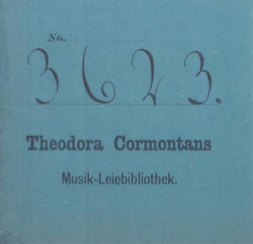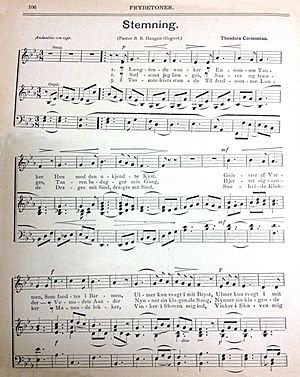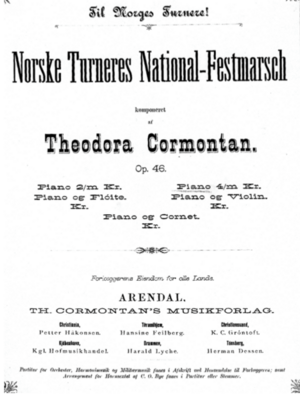Theodora Cormontan facts for kids
Theodora Cormontan (born June 9, 1840, died October 26, 1922) was a talented Norwegian American musician. She was a pianist, a music publisher, and a composer. Theodora was one of the first Norwegian women to have her classical music published and performed widely. She was also the first woman to start a music publishing business in Norway.
Contents
Her Life Story
Theodora started her music lessons in Arendal, Norway. Her father was a pastor there. In 1863, she moved to Copenhagen to study music further. But she had to return home in 1865 when her mother passed away. She then helped manage her father's household.
From 1865 to 1879, Theodora continued her music career in Arendal. She gave concerts, playing piano and singing. She also wrote music for piano and voice, and some of her pieces were published. She even started a music lending library. In 1879, she opened her own music publishing company. She focused on publishing music by other women composers.
In 1886, Theodora faced big challenges. A major bank failed, and her family home was destroyed by fire. She had to sell her music business. She then moved to the United States with her father and sister. She continued her music career there.
Soon after arriving in Sacred Heart, Minnesota, in 1887, Theodora was in a train accident. This injury made it hard for her to stand or walk easily. So, she stopped giving voice concerts. Instead, she focused on playing piano and organ. She also taught music, led choirs, and kept composing. She lived with her sister and later with her brothers.
After 1900, her family's money became tight. By 1910, at age 70, Theodora was the main person earning money for her family. After her brothers died, she and her sister moved into a home for elderly Norwegian immigrants in Decorah, Iowa, in 1917. Theodora passed away in 1922. Her music was mostly forgotten until 2011. That's when boxes of her musical works were found in St. Peter, Minnesota. Since then, her music has been recorded and shared in Norway, Denmark, and the US.
Early Music Career and Publishing
In 1869, Theodora Cormontan went on a concert tour. She sang as a soprano soloist in towns along the Norwegian coast. Newspapers praised her singing. One review said she had a "full, rich and sonorous soprano voice." It also noted her "beautiful and correct intonation." People loved her performances and applauded loudly.
Later, Theodora started a music lending library. In the 1800s, music was expensive to publish. So, lending libraries were a common way for people to access music. From 1875 to 1879, a leading Scandinavian music publisher, Warmuth, published some of her compositions.
Besides her concerts and composing, Theodora ran her own music publishing business from 1879 to 1886. Her company specialized in publishing music by other women composers. This included Sophie Dedekam, who wrote hymns, and Caroline Schytte Jensen, who became famous for children's songs. Theodora was the first to publish some of Schytte Jensen's well-known children's songs.
From the 1870s to 1884, Theodora's published music was sold in Norway, Sweden, Denmark, Germany, and Russia. She even published a song for Agathe Backer Grøndahl, another talented pianist and composer.
Moving to the United States
Theodora, her father, and her sister Eivinda moved to America in 1887. They moved because of a big bank failure and a fire that destroyed their home. They joined other family members who had already moved to the US.
When she arrived in Sacred Heart, Minnesota, Theodora continued her music career. She gave piano and voice concerts. She also advertised herself as a music teacher. On December 3, 1887, she was hurt in a train accident. She injured her spine. For the rest of her life, she needed help to walk.
In 1889, Theodora sued the railroad company for her injury. The company offered her $500, but she fought for more. The case lasted several months. The jury finally awarded Theodora $5,000. The railroad also had to pay all her legal costs.
In 1888, Theodora, her father, and sister moved to Franklin, Minnesota. They lived with her older brother, Gottfred. He was a chemist and owned a drugstore. The family joined a local Norwegian church. Theodora became the organist for two churches in the area. Her father died in 1893.
Because of her train injury, Theodora could no longer give voice concerts. These required her to stand for a long time. But she kept teaching music, playing the organ and piano, leading choirs, and composing. In the 1890s, she received great reviews for her concerts in southern Minnesota. People called her concerts a "rare treat." Some even listened from outside the town hall.
Even in 1910, at age 69, Theodora performed at public events. She played for the Red Cross and Farmer's Institute meetings. She was called a "pianist of rare ability." She continued to compose and copyright piano pieces as late as December 1911.
Church Music and Hymns
From 1890 to 1912, Theodora was part of a disagreement between two Norwegian church groups, the Norwegian Synod and the Hauge Synod. The Hauge Synod liked more modern, spiritual songs. The Norwegian Synod preferred traditional hymns.
Theodora was a member of the Norwegian Synod. Her father had been an important minister in the Norwegian Church. However, Theodora wrote several hymns for the Hauge Synod's magazine, Ungdommens Ven. She even dedicated one hymn to Rev. Bernt Haugan, a Hauge Synod minister. He later published a songbook called Frydetoner (Joyful Tunes), which included Theodora's hymns.
The Norwegian Synod did not approve of these new songbooks. But Frydetoner became very popular in Norwegian-American communities. It was printed at least 25 times! Theodora's hymns continued to be included in every new edition. This disagreement was finally settled in 1917 when the church groups merged.
Theodora's most famous hymn, Høgt frå den himmelske klåra ("High from the Clearing Heavens"), is still in the hymnal of the Church of Norway today.
Later Life and Retirement
As an unmarried woman in the 1800s, Theodora's money situation depended on her family. She lived with her siblings her whole time in the US. First, she lived with her married sister Maria. Then, she lived with her older brother in Franklin. When her brother ran his drugstore, the family was financially stable. In 1891, after Theodora won $5,000 from the railroad lawsuit, the family bought and donated an organ to a local church.
After her father died in 1893, her brother Gottfred became the head of the household. As he got older, his business struggled. He had to close his drugstore and work for another druggist in 1901. By 1910, Theodora, at age 70, was the youngest of four unmarried siblings living together. Like many elderly people without children back then, the family became poor. They relied on help from the county and church.
In 1915, the Cormontan household was listed on records for poor relief. Soon after her brother Gottfred died in 1917, Theodora and her sister Eivinda moved into a home for elderly people near Decorah, Iowa. Theodora died there in 1922 at age 82. Her sister Eivinda died two years later. Both were buried in the home's cemetery. Theodora's music was stored in boxes by the wife of the home's founder.
Her Lasting Legacy
Composing Legacy
For about 80 years, most of Theodora's music was forgotten. But one hymn and one song remained known. Her hymn, Høgt frå den himmelske klåra, stayed in the Church of Norway's hymnal. In 2011, a Norwegian jazz singer even recorded it.
In 1988, one of Theodora's songs, "Aftendæmring" ("Twilight"), was sung by an actor named Christian Steffensen. It was part of an album of poems set to music. The song received special praise. Steffensen continued to perform it and released recordings in Danish and English.
Library and Publishing Legacy
Music that Theodora published from 1879 to 1886 can be found in archives in Norway. It is also in the collection of Michael and Bonnie Jorgensen. Michael is a music professor, and Bonnie is a pianist.
In 2011, the granddaughter of the nursing home superintendent (where Theodora spent her last years) gave Theodora's musical library to the Jorgensens. This happened after they met by chance in a grocery store! Bonnie and Michael Jorgensen have since given talks and concerts about Theodora's music. They have also recorded many of her compositions. They even created a website to share her story.
In May 2015, the Jorgensens donated Theodora Cormontan's published and handwritten music to the National Library of Norway in Oslo. They also performed her music there. A few days later, they gave a concert in Theodora's hometown of Arendal.
List of Works
Published in Norway:
- 4 Sange [4 Songs] op. 2 /Hvad jeg elsker [What I Love] (voice/piano; Hans Christian Andersen text), Warmuth Publishing Company, 1875
- Blandt Fjeldene [Among Mountains] op. 3 (piano), Warmuth, 1875
- 3 Religiøse Sange [3 Religious Songs] op. 5 /Dyb Sne [Deep Snow] (2 voices/piano; Halfdan Sommerfelt text), Warmuth, 1877
- 3 Sange op. 4 /Aftendæmring [Twilight] (voice/piano; H. C. Andersen), Warmuth, 1877
- 4 Sange op. 6 /Holder du af mig [If you like me] (voice/piano; Bjørnstjerne Bjørnson text), Warmuth, 1879
- 4 Sange op. 1 /Det døende Barn [The dying Children] (voice/piano; H. C. Andersen), Cormontan Publishing Company, c 1880
- Hvad ønsker du mer? [What would you like more?] op. 8.1 (2 voices/piano; F. W. Krummacher text) , Cormontan, c 1880
- Fred til Bod for bittert Savn, [Peace of Penance for bitter Longing] Fantasie-Transcription (piano), Cormontan, 1883
- Herre Jesu Christ, [Lord Jesus Christ] Fantasie-Transcription op. 36 (piano), Cormontan, 1885
- Honnør-Marsch for norske Turnere [Honor March for Norwegian Turners] op. 44 (piano), Cormontan, 1885
- Kjærlighed er Livets Kilde, [Love is the Source of Life] Fantasie-Transcription op. 42 (piano), Cormontan, 1885
- La Eleganza, [Elegance] Menuet op. 10 (piano), Cormontan, 1885
- Norsk Konge-Polonaise [Norwegian King-Polonaise] op. 43 (piano), Cormontan, 1885
- Norske Turneres National-Festmarsch [Norwegian Turners National Festival March] op. 46 (piano), Cormontan, 1885
- Til Kirke [The Church] op. 8.2 (voice/piano; H. Sommerfelt), Cormontan, 1885
Published in the United States (all piano solo):
- Waltz Gracious op. 53, Johnson and Lundquist, (n.d.)
- Polka Fantasia over Swedish Song op. 54, Thompson, 1895
- L'Elegance op. 10 (same piece as op. 10 above), Hatch, 1900
- A Jubilee Rhineländer op. 58, Pioneer, 1905
- Dance de la Duchesse op. 59, (publisher unknown), 1906




